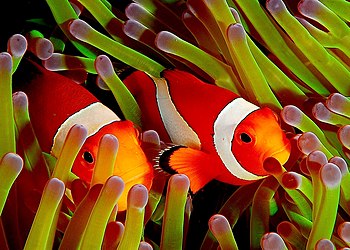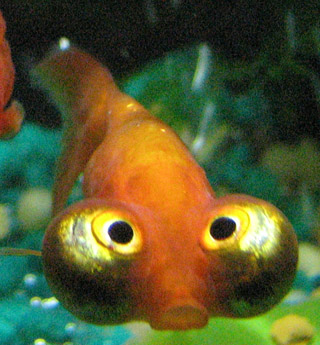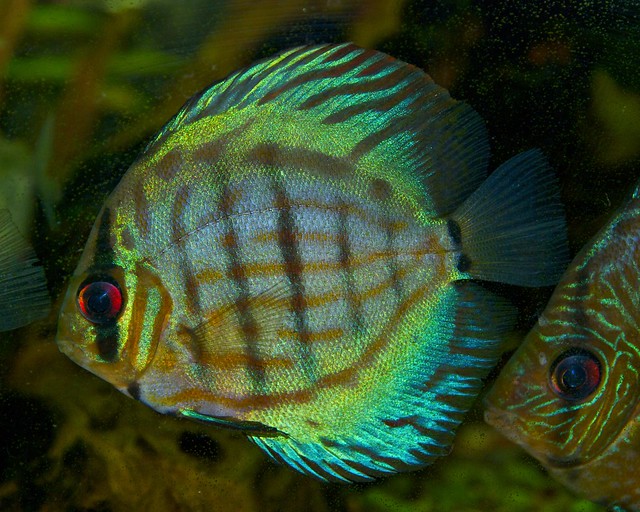 |
| On Black Ocellaris clownfish, Amphiprion ocellaris. Some clown anemonefishes are brave. When divers close to them, papa anemonefish will swim out to defense. (Looks like very angry!!) But, often they will hide. (papa will hide faster than their babies. haha~) Lovely!! (Photo credit: Wikipedia) |
Depending upon the species these may be overall yellow, orange, reddish, or blackish while others may bear patches or bars. The largest species are not to attain a body length of about 18 centimeters while the normal range of body length is about 10 centimeters. The well known popular movie entitled Finding Nemo by the Pixar/Disney figures out the clownfish as the leading character.
Clownfish are known to inhabit the warmer waters of Indian and Pacific oceans along with the Great Barrier Reef and the Red Sea. The majority of the species are known to dwell in restricted areas while others have a wide range of distribution. They are generally hosting specific but some species also show coordination with other species also. They are known to dwell at the bottom of the seafloor confined in the shelters of lagoons or coral reefs. They prefer to live in pairs.
They are also distributed in northwest Australia, Southeast Asia, Japan and the Indo-Malaysian region but totally absent in the Caribbean region. They are known to feed on small invertebrates otherwise they may cause damage to the sea anemone. The fecal matter released by these fishes acts as a source of nutrients for the sea anemone. They are strictly omnivorous and their gut content has revealed that their diet includes 20-25% of algae. The diet comprises of copepods, algae, zooplankton, and algae. They also feed on small crustaceans and mollusks. When kept under captivity they are provided fish pellets and fish flakes and food. They also feed on the undigested food material of the sea anemones.
Clownfish and certain damselfish are the only known species of fishes which are able to remain unaffected by the poison secreted by the sea anemone. Many theories have been put forward to support this view. According to one view, the mucus coating of the fish may be composed of sugars rather than proteins so the sea anemone fails to recognize the fish as food sources and does not attacks it. Another view suggests that due to co-evolution clownfish have developed immunity against the toxins secreted by the sea anemone.
It is well known that they tend to live in pairs in a single anemone and when the female dies the male changes its sex to female. This process is known as sequential hermaphroditism. Clownfish are born as males and that is why they are protandrous hermaphrodites. On top of the hierarchy reproducing females is presently followed by the male but if the female dies this hierarchy gets disrupted. The largest member of a group is a female and the second largest one the male. Clownfish are neuter which means that they do not have fully developed sex organs for either gender.
Clownfish prefer to lay their eggs on flat surfaces where they can adhere properly. Spawning generally occurs around the time of the full moon. The male is known to guard the eggs until they hatch after 8-10 days. They lay eggs ranging from hundreds to thousands. They are the first known fishes to breed in captivity. The average life span is of 6-10 years but in captivity, they live up to 3-5 years. They show a special association with the sea anemone. The activity of these fishes results in a greater amount of water circulation around the sea anemone and sea anemone provides them protection from its toxins. Clownfish depends on the sea anemone for its daily food.
When anemone paralyzes a fish and consumes it these fish eat the chunks and pieces left after the feeding of the anemone. The fish also keeps the anemone free by eating up its dead tentacles and act as a lure by attracting predators towards itself by its bright coloration. This sort of symbiotic association of the clownfish with the sea anemone makes them the most astonishing creatures living underwater. They are known bred in captivity in the marine ornamental farms in the USA. If the anemone of the aquarium dies they tend to live in the soft varieties of corals. The corals may agitate the skin of these fishes and in some cases may kill the corals also. Once they get confined in the corals they defend it. We can conclude that they are amazing fishes showing unique features.
|








